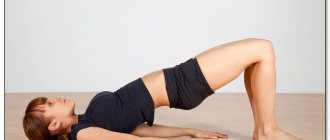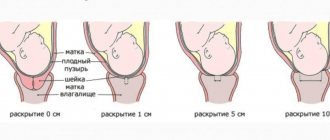Giving birth on a stool: pros and cons
Most recently, I defended my PhD thesis at a medical school on the topic “Optimization of methods, techniques and methods of childbirth”, and now, as a candidate of medical sciences, I would like to briefly share my thoughts.
In my dissertation, an entire section was devoted to vertical childbirth. I would like to call my story “Childbirth: pros and cons.”
As you know, today the classic method of childbirth is childbirth “lying on your back,” although this method became such only recently; until the twentieth century, childbirth was not performed this way anywhere in the world. This is no accident. This method is the most painful for a woman in labor - the baby puts pressure on the spine and lower back, plus there is no help from ordinary gravity.
In my opinion, the only thing worse than this method is birthing upside down - when a woman in labor hangs upside down on a horizontal bar and gives birth (it’s strange why this method is not yet practiced anywhere, it’s very convenient for obstetricians, but the woman in labor doesn’t care). What I mean is that in the “lying on your back” position, it is very convenient for obstetricians to give birth, and our women, not suspecting that there are easier ways of childbirth for them, agree, attributing all the pain to the fact that “this is how it should be” .
But, as you know, all wisdom comes from antiquity. And in the old days, births were never performed in this form anywhere; all births were exclusively vertical. This is probably why in the old days our grandmothers and great-great-grandmothers gave birth to 10 or more children without much pain, in fields and hayfields, quickly and easily. And isn’t that why childbirth is so painful for most women today, many young girls are panicky afraid of even the word “childbirth”.
From the point of view of physics, during vertical childbirth, the mother in labor is greatly helped by gravity - the fetus comes out easier under the influence of gravity. Further, it is easier for a woman in labor to push; anyone in an upright position has better control of their body. As a result, childbirth goes faster, which already gives it an advantage compared to horizontal births.
Let's look at the different types of vertical births. In Rus', as a rule, people gave birth in baths, standing and leaning against the wall. With all the advantages of vertical birth, there is a minus - the birth must be carried out by at least two people - one takes it directly, the second holds the woman in labor, since in a standing position the human body is unstable, and during contractions and pushing, any sudden movement is fraught with serious consequences for the fetus and mother, and is tolerated in a standing position, I think everything is not very comfortable.
Or another way - Chinese - squatting, the same disadvantages, plus it is extremely inconvenient for the obstetrician to deliver the child. Childbirth on all fours lacks the main advantage - the help of gravity, and can be called vertical rather conditionally. It turns out that vertical births also have many disadvantages over horizontal ones.
A year ago, while in Amsterdam for a practice, in one of the maternity hospitals there, I saw a special chair on which they give birth, the woman in labor sits on it, pushes, and the baby comes out into a special hole in the chair. The birth took place quickly and quite easily, there were no ruptures, after five minutes the woman in labor was already holding the baby in her arms.
Having already arrived in Russia, I rummaged through a lot of information and came to the conclusion that childbirth on a chair is a method of childbirth that is devoid of the disadvantages of both horizontal and vertical childbirth. Sitting steadily, the woman in labor can not be afraid that if she makes a sudden movement, she will injure the child while still in her body and her body. The force of gravity helps her push, and in a sitting position, the muscles of the pelvic floor and perineum are in a state that is most convenient for the delivery of the fetus, which in turn reduces gaps and speeds up labor. Contractions are also easier to bear when a woman is sitting, and it is better for her to even walk at this time, but just not lie down. When equipped with this delivery chair, childbirth becomes convenient for the obstetricians themselves.
In conclusion, I can say, dear women, if you have the opportunity to give birth vertically, in particular, on such a chair (some maternity hospitals are already actively introducing this innovation), do not hesitate to agree. In this case, you will get: a faster outcome of childbirth (few people received pleasure from the actual birth), a much reduced chance of perineal ruptures (suturing, then you can’t sit for a week - also unpleasant), and in the end, your childbirth will be much easier, but why? suffer.
But even when introducing such births, obstetricians are in no hurry to offer them, since it is easier for them to deliver on the back. First of all, you should think about yourself and the child, because an easy birth is an easy birth not only for you, but also for your child. So decide for yourself.
Elena Zemtsova, Candidate of Medical Sciences
Important aspects of preparing for home birth
In order for alternative childbirth to be successful and the risks to be minimized, the pregnant woman must undergo serious training.
In Rus', every village had a midwife who had extensive experience and could help a woman in labor in word and deed. Also, if necessary, neighbors and grandmothers could contribute to the birth of a child. Modern friends of pregnant women, as well as their mothers and mothers-in-law, as a rule, are not at all prepared for this.
For many centuries, births in Russia were assisted by midwives who knew their job well.
It is imperative to prepare for home births. And this concerns not only the expectant mother, but also the close people around her.
First of all, a pregnant woman should notify her doctor of her desire to give birth to her baby at home. The next step will be the choice of a special school, which is precisely designed to prepare such married couples. During the course, the husband and wife meet experienced obstetricians and receive detailed and visual representations of the upcoming procedure. Such training gives future parents the opportunity to strengthen themselves or, conversely, to be disappointed in their decision.
A couple planning a home birth must attend special courses to prepare for this procedure.
Physiological aspects of training
The physical condition of the pregnant woman is important for the upcoming alternative birth. For example, during the entire period of bearing a baby, a woman must be responsible about her nutrition: the fetus does not need to be overfed so that it is not too large; her own excess weight will also complicate labor. Shortly before the baby is born, you need to limit the consumption of fats and carbohydrates, reduce the volume of liquid consumed to 1.5 liters.
In addition, it is very important that the muscles of the expectant mother were strong at the time of childbirth, because the woman will face a colossal load on the body. Special fitness for pregnant women will help with this. The most optimal thing is to do Pilates (as an option, Aqua Pilates) and do exercises with a fitball.
The main thing is that classes should not be occasional, but regular: at least three times a week. Only then will the muscles receive the necessary load and remain in good shape.
Pilates is a set of exercises based on the interaction of mind and body. What is important here is awareness of the impact of each exercise on a specific muscle group, as well as concentration on the breathing rhythm. The Pilates method uses deep (“rib”) breathing, which allows movement (including bending) without limiting the volume of air inhaled. In addition, during training, the movements are very smooth: each movement imperceptibly follows from the previous one.
Pilates will bring a lot of benefits to a pregnant woman:
- Training in chest breathing, which is important during contractions.
- General strengthening and relaxing effect on the body.
- Improving blood circulation in the pelvic area, which is where the main load is experienced during childbirth.
- Strengthening the spine.
- Exercises help the fetus to occupy the correct position in the uterus, which will subsequently facilitate its birth.
- Any physical activity contributes to the emotional balance of a pregnant woman and eliminates possible stress.
As for aquapilates, the indicated beneficial qualities also include staying in a comfortable aquatic environment. This eliminates the possibility of overheating and relieves fatigue. A woman learns to hold her breath, which again will be very useful during childbirth.
You should start doing Pilates and Aqua Pilates no earlier than 12 weeks of pregnancy.
Pilates trains a woman's chest breathing, which is very important during childbirth.
Fitball is training with a large ball made of durable material. It is unstable, so it will be quite difficult for a woman to maintain balance on it. This activity brings the following benefits:
- Coordination of movements is improved.
- The load is evenly distributed over the entire muscle frame.
- Metabolic processes improve.
- Blood circulation increases.
- Helps the fetus to move into the correct position.
You can start exercising on a fitball from the earliest stages of pregnancy, even if the expectant mother has never played sports before. It is only important to select the ball in accordance with the height of the pregnant woman and not to inflate it to the limit so that it bends a little under the weight of the body.
Exercising on a fitball improves the coordination of movements of a pregnant woman and evenly distributes muscle load.
In addition to the above training, daily light exercises and water procedures will be useful in preparing for childbirth. Swimming uses almost all muscle groups. It has been noticed that women who are passionate about this activity give birth faster and easier than others.
Swimming promotes faster and easier childbirth
Psychological attitude
In addition to good physical shape, for a home birth, a pregnant woman will also need an appropriate moral attitude and a strong psyche. This is also very important for the spouse and other close people (they may also be present during the exciting event): after all, nervous people will only worry the expectant mother.
It is useful for a woman (or better yet, a married couple) to visit a psychologist: he will simulate the situation that will occur during childbirth. Training videos and conversations with a gynecologist and obstetrician will also help in this regard.
A psychologist will help you simulate the situation of childbirth in advance and mentally prepare the woman for it.
Self-hypnosis techniques help to create a positive attitude and get rid of anxious thoughts. The expectant mother should often repeat such phrases out loud and to herself: “My birth will be wonderful,” “My body will cope with everything perfectly,” “The baby and I are completely fine,” “I am completely ready to give birth at home,” etc.
You need to repeat positive phrases out loud and to yourself more often that the birth will be wonderful.
A great way to overcome the psychological uncertainty about home birth is to talk to couples who have already successfully gone through this procedure. They will tell you about all the pitfalls, the pros and cons of the process.
If one of the relatives is skeptical about the future mother’s desire to give birth at home, he does not need to make her nervous, but rather reconsider his decision. After all, it can be difficult to convince a pregnant woman of something: she often feels in her gut what is good and what is bad for her child.
Organization of the place for childbirth, necessary supplies
To give birth at home, certain conditions are required. First of all, this is the presence of a separate room (the process will be, for example, inconvenient in a one-room apartment, where another child also lives). The house must have cold and hot water and electricity. The lighting should be quite bright so that the midwife can clearly see the genitals of the woman in labor.
If you plan to give birth in water (this is a popular type of home birth), you will need a large pool or bathtub.
The family should take care to prepare the following things in advance (do not leave this until the last minute, since contractions may begin suddenly):
- Clean sheets, diapers, large oilcloth.
- Sanitary napkin.
- Sterile wipes, cotton swabs.
- Enema.
- A container in which the placenta can be placed.
- A small rubber bulb (aspirator), with which you can free the newborn’s nose and mouth from mucus.
- Keep a heating pad with ice in the freezer: This will help stimulate uterine contractions after birth.
- Strong scissors for cutting umbilical cords.
- Hydrogen peroxide, brilliant green solution for treating the baby's navel and mother's perineum.
- Suture material (if the midwife needs to sew up the perineum).
- Herbal decoctions with antiseptic properties (chamomile, oak bark, calendula, etc.) for washing after childbirth. They should be prepared immediately at the onset of labor. Ice cubes of nettle decoction are also useful for emergency stopping of bleeding (a first aid measure in case of complications before the ambulance arrives).
Photo gallery: necessary things for childbirth at home
To treat the newborn's navel and mother's perineum you will need hydrogen peroxide and brilliant green.
An ice pack placed on the lower abdomen after childbirth will help the uterus contract faster after childbirth.
At the onset of labor, a woman will need to undergo an enema to cleanse the intestines.
An aspirator will be needed to clear mucus from the baby's nose and mouth.
During childbirth, you will definitely need sheets, diapers, oilcloth
Nettle ice cubes can be useful due to their hemostatic properties.
Medical assistance during childbirth at home
To minimize the risks associated with a home birth, it is necessary to be accompanied by a health care professional. The expectant mother will have to follow all her instructions and advice.
You need to agree in advance with an experienced midwife with the appropriate diploma and certificates (it’s good if she is recommended by friends who have already successfully gone through such a procedure). The married couple needs to meet with her in advance (preferably more than once), discuss all the important points, and draw up a detailed plan for the upcoming birth.
You need to carefully select a midwife. There is no need to rush in this matter: if necessary, several applicants should be considered.
The presence of a person with extensive experience in childbirth has a very positive psychological effect on the pregnant woman. Moreover, it is very important that the pregnant woman establishes a trusting relationship with the medical worker. The successful outcome of childbirth largely depends on this.
Choosing a midwife for a home birth must be approached responsibly









